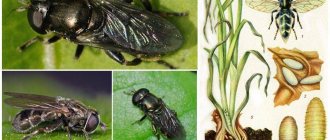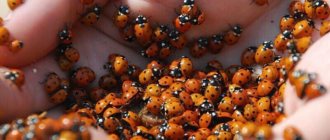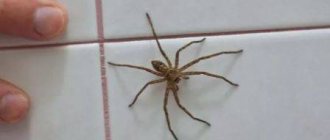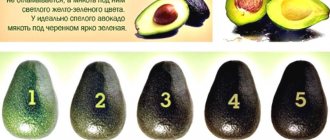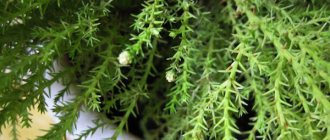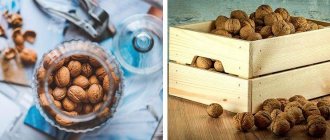- April 5, 2019
- Tips for tourists
- Elena Motrenko
The ladybug is one of those insects that people find attractive. Children especially like these creatures. This insect is common in all countries of the world. It is very difficult to confuse a ladybug with other beetles due to its unusual coloring. But oddly enough, we don’t know as much about her as we think. In this article we will take a closer look at this cute insect and find out what ladybugs eat.
Name
People's positive attitude towards the ladybug is also reflected in the name given to the insect. The epithet “God’s” in its name is present in many countries. Catholics call the insect ladybird or ladubug. At the same time, lady means in this case the Virgin Mary. That is, the ladybug is, in their understanding, an insect of the Mother of God. Translated from French, the name of this animal means “chicken of God.” In other countries of the world, the insect is called no less poetically. Translated from many languages, it usually means some animal belonging to God.
According to popular beliefs, a ladybug descends from heaven and brings goodness with it. This insect has always been treated as a holy creature, killing which was considered a sin.
https://youtu.be/nZqD17eYQBQ
Video
And finally, an interesting video about ladybugs.
Author: Pavel Chaika, editor-in-chief of Poznavaika magazine
When writing the article, I tried to make it as interesting, useful and high-quality as possible. I would be grateful for any feedback and constructive criticism in the form of comments on the article. You can also write your wish/question/suggestion to my email [email protected] or Facebook, with respect, the author.
Author page
Description
Perhaps this is the most famous representative of beetles for both adults and children. There are few people who would not know what a ladybug looks like.
This insect has a round body. It is convex on top and flat on the bottom. The most common ladybugs in nature are red and yellow with black spots on their backs. But these are not all types. There are about four thousand of them in total. Ladybug also comes in black, blue, cyan and other colors.
Instead of dots on her back, she may have stripes and even patterns that resemble letters.
Bright coloring is necessary for the ladybug to protect itself from predators. If this insect gets caught in a spider's web, it has a chance of salvation, since the enemy himself tries to get rid of such a captive by breaking his own trap.
The ladybug has a pair of wings with which it can fly. They are protected by a pair of elytra located on top.
There is a pair of black antennae on the head. The ladybug has three pairs of long legs. A liquid with an odor is released from their folds when the insect senses danger. Ladybug has the ability to play dead if something threatens her. She falls on her back and presses her paws.
Interesting Facts
Habitat
The ladybug can be found anywhere in the world except Antarctica and permafrost zones. This insect prefers to settle on trees, meadow grass or on plants growing near water bodies.
Like migratory birds, ladybugs gather in flocks in spring and autumn and fly long distances. This happens for the purpose of searching for food. When flying, the bugs fly quite high. They cannot be seen with the naked eye. Strong winds can prevent them from doing this. Because of its gusts, insects are forced to interrupt their flight, and if they are above the sea, this often leads to their death.
Many ladybugs overwinter in the forest, hiding under leaves or under the bark of stumps until spring.
Can this insect bite or not?
It is believed that the ladybug is the most peaceful creature that can never hurt a person. In fact, the friendly nature of an insect can be replaced by an aggressive attitude under the influence of certain factors. For example, the long flights that insects make before the onset of cold weather are very tiring for small bugs. They are especially exhausted by bad weather - strong wind or rain, under the influence of which such insects fall to the ground. Finding themselves on a person at such a moment, they can pinch him with their micro-claws. Stress, what can I say.
Only a yellow or ladybug with 28 spots can truly bite. When you count out loud to twenty-eight, expect a cow bite. In their usual habitat, these insects do not attack humans. But in a stressful situation they can bite, causing noticeable pain.
Harlequin ladybug (lat. Harmonia axyridis)
Reproduction
In spring or fall, ladybugs lay yellow eggs on plant leaves. Their number varies from five to three hundred pieces. The larvae appear within a week. They have well developed jaws. Larvae eat more food than adults. They have a dark green color that camouflages them against the background of the leaves.
After two weeks, a pupa forms from the larva, and after the same period of time, a young ladybug bug appears. At the beginning, he has no patterns on his wings, and the color is still too pale. Over time, the beetle acquires a rich color and pattern. The entire development process from egg to mature individual takes four to seven weeks.
Having completed its mission, the ladybug dies. The insect's life cycle lasts just over a year. A new generation of ladybugs will soon prepare for the winter, after which they will hatch their offspring and then also die.
Looking at this cute insect, many wonder what ladybugs eat. Let's look into this further.
Why is the bite dangerous? Is it poisonous to humans?
The bite of almost all varieties does not pose a danger to humans. The affected area of the skin turns red and begins to itch. But after a few hours the discomfort disappears completely.
An exception is the bite of a yellow ladybug (harlequin). Another name for the insect is variable harmony (Harmonia axyridis). At the actual site of the bite, only a small spot remains. But the poison contained in the saliva and on the legs of the insect can cause severe allergic reactions in both animals and humans. A few minutes after the lesion, the following clinical signs of allergy begin to appear:
- swelling of the mucous membranes;
- severe dizziness;
- rapid heartbeat, tachycardia;
- loss of orientation in space;
- lack of coordination.
The bite of a ladybug with 28 points also causes similar consequences. As first aid and prevention, a person bitten by these insects should take a dose of an antihistamine (suprastin, diazolin, tavegil).
The ladybug laid eggs. Soon there will be offspring.)
Nutrition
These cute-looking bugs are actually predators. This makes them very useful for gardeners. Why? This question can be easily answered by learning more about what ladybugs eat. The basis of their diet is garden pests.
Ladybugs help preserve cultivated plants by eating harmful insects. They especially love to feast on aphids, which, as is known, destroy all plantings. For the development of one ladybug larva, about a thousand of these insects are needed. An adult beetle consumes about two hundred aphids per day. This is a huge help to people in saving their crops from destruction. Other beetles that lack a shell are also eaten.
Many people have a question: what do ladybugs eat besides animal food? Sometimes there are species of this insect that are vegetarians and feed on plants, namely mushrooms and leaves. Almost all of them live in Latin America and southern East Asia.
In our country, there are only three species of such ladybugs: spotless coccinellids, alfalfa bugs, and twenty-eight-spotted ladybugs. They are distributed in the central and southern parts of Russia and the Far East, respectively. These species can harm garden plants.
The larvae feed similarly. They differ from adults only in the amount of food they eat. Now we know what ladybugs eat in nature.
What do ladybugs eat and what do they feed on at home?
For some, it is surprising to learn that the ladybug is a predator. They eat insects and their larvae, most of which are pests. The most favorite food of ladybugs is aphids and their larvae. One ladybug can eat more than 6,000 aphids in a year and a half. So these colorful bugs are unknowingly saving agricultural lands from harmful parasites.
In addition to aphids, the ladybug eats small pest caterpillars, slugs, eggs of butterflies and the Colorado potato beetle, scale insects and spider mites.
Life cycle of ladybugs
During the spring and summer months, the ladybug eats enough food and accumulates reserves for wintering. As soon as the cold weather sets in, these beetles begin to hibernate, and in the spring a new round of life begins, and those ladybugs that were able to survive the winter begin to lay larvae, but by the time the new generation reaches full life, these individuals are already dying. However, ladybugs have a very large population, so in nature we meet them quite often, both in the forest and in the concrete jungle of megacities.
In scientific books they are called “Coccinellidae”, or “Coccinellidae”, in other countries the ladybug is called differently: “St. Virgin Mary’s beetle”, “St. Anthony’s beetle”, “Sun”. In Tajikistan they are called “Redbeard Grandfather”. This name shows how sensitive summer residents are to beneficial insects.
What does a ladybug eat in winter?
In winter, ladybugs do not feed on anything, as they hibernate or go into a state of suspended animation. Before winter, ladybugs accumulate glycerin and sugar in their tissues, and also remove large amounts of water from the body, so that when cold weather sets in and the body cools, they do not burst from the temperature change.
With the onset of cool days, insects begin to look for warm places to winter. Ladybugs can concentrate in large numbers in one place for the winter. Before wintering, insects fly in flocks over the city in search of a new shelter. Most often, ladybugs remain for the winter in heaps of dry leaves, in bark, under stones, in forests, in window cracks, sometimes organizing huge clusters. There are often cases when ladybugs fly into private houses and apartments, hide in window frames, behind curtains, behind baseboards and in other inconspicuous places, and then the owners find them in a sluggish state of winter suspended animation.
Ladybugs are very useful: they themselves and their larvae feed on pests - aphids. So if ladybugs decide to spend the winter in your garden plot, you can be sure that in the summer you will be protected from aphids in your garden. But do not rush to completely plow the area, otherwise you will lose your defenders from aphids for a long time. For this small predator, only the human hand is dangerous; they die en masse from the poisons that gardeners spray their gardens with. Therefore, leave a few places with fallen leaves so that the cows have a place to hide and survive the winter.
Content Rules
Now let's figure out what ladybugs eat at home. It often happens that winter comes unexpectedly earlier than usual. Ladybugs do not have time to prepare for this and hibernate. In this case, insects do not have the opportunity to survive until spring. Only a person can help them. And then the question arises: what to feed ladybugs?
Insects are quite capable of surviving at home, and caring for them does not require much work. That small list of what you need to feed a ladybug can be found in every home. For this purpose, honey diluted in water, water sweetened with sugar, raisins and leaves of vegetable plants are suitable.
Ladybugs need to be placed in a cool place. One option is a window sill or a gap between the frames. The beetles need to be fed for several days. They will then hibernate until spring.
Now we know what ladybugs eat at home, and we can always help these cute and useful insects.
Care and caution
The ladybug is small (an adult reaches an average of 0.8−1 cm) and fragile, so any attempt to pick it up or play with it can lead to negative consequences. Precautionary and careful measures when caring for a bug are the following:
- It is better to catch the animal with a net.
- In order to take an insect in your hand, you need to place your finger next to it and wait for it to climb onto it.
- The ideal temperature for life and reproduction of Coccinellidae is considered to be +20 ⁰ C, so it is recommended to avoid hypothermia.
Do not forget that your pet is an insect, so after each contact with it it is recommended to wash your hands thoroughly with soap.
How to purchase
As you know, the main thing that ladybugs eat is aphids. Since this insect and its larvae are very useful for growing crops, many farmers would like to have them in their fields. Today it is very easy to do. You can simply buy them, create the right conditions for them and plant them in your garden or field.
The eggs of these aphid killers can be purchased not only in gardening centers, but also simply on the Internet. The order will arrive by mail. All that remains is to breed the beetles.
One of the conditions is a complete rejection of pesticides. Otherwise, insects will not live in an environment unsuitable for them. They should be released into the garden at cooler times of the day: in the morning or evening. If there is no dew, you should spray the plants with water. That's all you need to know about breeding ladybugs. These rules are quite simple, and the benefits from these insects are disproportionately high.
What do ladybugs eat at home: insect diet
The ladybug, despite its defenseless appearance, is a predator. They hunt insects and actively eat larvae.
Aphid larvae and adults are considered their favorite food.
Over the course of a year, spotted predators are capable of eating approximately 6,000 aphids. But what do ladybugs eat at home, what is the insect’s diet?
Features of a ladybug
The ladybug is an interesting insect. Its lifespan in its natural habitat reaches up to three years.
The bright color of the bug gradually becomes lighter. This is especially true for the dark spots on his back.
The size of an adult does not exceed 1 cm. The respiratory openings are located on the lateral surfaces of the body.
The bug is not harmful to humans, but when a threat arises, it is capable of producing an orange secretion that is toxic to other insects. If the smell doesn't work, he knows how to play dead.
An insect can successfully exist in an apartment, but for a relatively short time.
In enclosed spaces it is capable of making only small masonry. At the same time, both the younger and older generations remain alive.
Reproduction and life cycle
The female uses leaves and stems of plants to organize the clutch.
At one time she lays 200 - 400 eggs. It takes approximately 7 days for the larvae to emerge. Visually, they resemble miniature crocodiles.
In order to successfully pupate, the larva must eat at least 400 units of aphids.
The maturation of the larva goes through several stages. 30 days after leaving the egg they become pupae. After 7 days, young beetles emerge from the cocoon.
During this period, they completely repeat the appearance of their parents, i.e. have a characteristic bright color, which warns other insects of danger, and black spots on the shell.
Diet of ladybugs
What does a ladybug eat? This insect, despite its small size and friendly appearance, is a dangerous predator that feeds on other species.
The main portion of the diet is represented by aphids and their brood. If necessary, the bug catches other insects that do not exceed its size.
The diet of the small predator includes:
An adult is capable of eating 140–210 units of adult aphids or 390 larvae in one day.
The insect can burrow into the soil, reaching the root system of plants.
Here it also preys on parasitic aphids.
In the wild
What does a ladybug eat in nature? Bugs are found in gardens all over the planet, because they prefer to hunt not only small-sized representatives of the insect world, but also actively destroy various pests of agricultural crops.
What does a ladybug larva eat? After spring mating, mature females lay eggs in certain places. This could be a large colony of aphids or other small insects.
After the larva emerges from the shell, it begins to actively eat nearby insects until pupation. After completing this stage, the adult beetle feeds like its relatives.
At home
Sometimes ladybugs fly into apartments. If this happened in early or mid-autumn, then the bug can be left indoors for the winter.
To do this, it is necessary to organize a house for her that corresponds to shelter in natural conditions.
Place several thin twigs or sticks at the bottom of a liter glass jar and transfer the insect into it.
What do ladybugs eat at home? The insect can be fed with honey or granulated sugar dissolved in warm water.
The result should be a sweet liquid. You need to moisten a piece of cotton wool or gauze in it, which you place at the bottom of the jar.
What else can you offer an insect?
In addition to sweet syrup, ladybug will like:
- soaked raisins;
- a fully ripened apple, cut into slices;
- lettuce – its white part.
